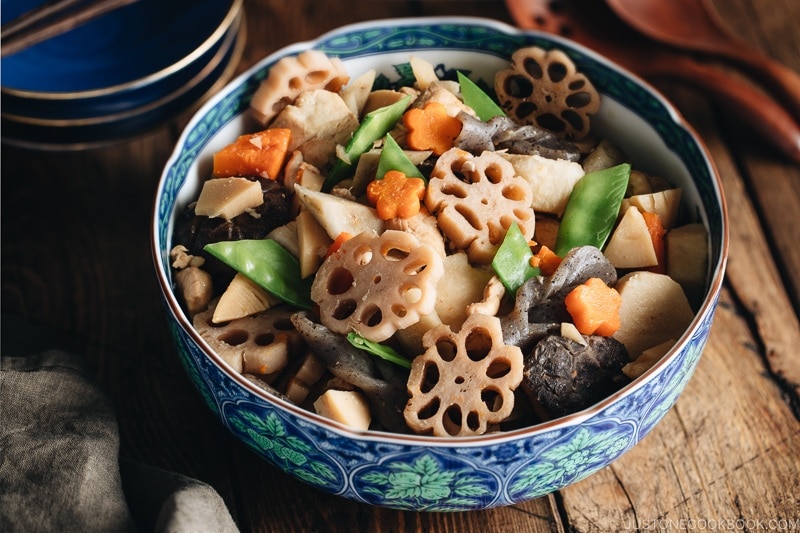Instant Pot Nishime
4.3
(18)
Your folders
Your folders
Prep Time: 30 minutes
Cook Time: 55 minutes
Total: 85 minutes
Servings: 6
Cost: $6.58 /serving
Author : Namiko Chen

Ingredients
Export 14 ingredients for grocery delivery
Instructions
Step 1
Gather all the ingredients.
Step 2
In a small saucepan, add 1 cup water and 1 dashi packet. Slowly bring to a boil on medium-low heat, while gently shaking the bag a few times to get more flavors. Once boiling, lower the heat and cook for 1 minute. Then turn off the heat. If you want to make dashi with dashi powder, click here.
Step 3
Remove the pot from heat and remove the dashi packet. Add the dried shiitake mushrooms in dashi to rehydrate for 15 minutes.
Step 4
Remove the tough strings off the snow peas.
Step 5
Make Tazuna Konnyaku. Slice konnyaku to about ⅛ to ¼ inch (7-8 mm) thick. At the center of each slice, make a 1 ½ inch slit.
Step 6
Put the top or bottom part through the hole. Push it in and pull out both ends.
Step 7
Boil water in a saucepan over medium-high heat. Add a pinch of salt and blanch the snow peas for 30-60 seconds, until crisp but tender enough to eat. Transfer snow peas to a sieve/plate.
Step 8
In the same boiling water, add the konnyaku and cook for 2-3 minutes to remove the smell (which is why you cook after snow peas).
Step 9
Cut the bamboo shoot into quarters. Keep the tip into 1 ½ inch length (so it will look pretty), and slice the rest (bottom) of the piece.
Step 10
Peel the lotus root skin and cut in half.
Step 11
[Optional] If you want to make Hana Renkon (Flower Lotus Root), here is the tutorial.
Step 12
Slice the lotus root into ¼ inches and soak in water (or 2 cups water + 1 tsp vinegar to make the lotus root whiter).
Step 13
Peel and cut the carrot using Rangiri Japanese cutting technique. [Optional] If you like the flower shape carrot, then first cut the top 2 inches into ¼ inch slices. And cut the rest of carrot using Rangiri cutting technique.
Step 14
[Optional] Cut out the carrot into a flower shape. You can eat the cutout carrot (mince it and use in fried rice or soup).
Step 15
Peel the taro skin with a sharp knife. It’s very tough, so I don’t recommend using the vegetable peeler. Instead, use a knife to slowly peel the skin. For taro, it’s recommended to peel the skin thick (It’s not considered wasteful to remove skin with more flesh attached).
Step 16
Cut each taro in half and soak in water to get rid of starch and astringent taste.
Step 17
Lightly peel the gobo skin with the back of your knife (unlike taro, you want to preserve the flesh as much as possible as the flavor of gobo stay right under the skin). Cut the gobo using Rangiri Japanese cutting technique and soak in water to get rid of starch and astringent taste.
Step 18
By now the dried shiitake mushrooms should be soft and hydrated in the dashi. Squeeze the liquid out from the shiitake mushrooms. And strain the dashi over a fine mesh sieve over a measuring cup. You will need 200 ml (= take away 2 Tbsp from 1 cup).
Step 19
Discard the stem of shiitake mushrooms. [Optional] Cut the edges to make into a hexagon, which represents turtle shape for longevity.
Step 20
Cut the chicken tender using Sogigiri. cutting technique. It creates more surface which allows the chicken to cook faster and absorb more flavors.
Step 21
Press the “Sauté” button on your Instant Pot and heat 1 ½ Tbsp sesame oil.
Step 22
Add the chicken tender and coat with oil.
Step 23
When the chicken is no longer pink outside, add the lotus root, taro, gobo, and bamboo shoot. Then add the dashi.
Step 24
Add 1 Tbsp sugar, 2 ½ Tbsp mirin, 1 Tbsp sake, 3 Tbsp usukuchi soy sauce (light color), and ½ tsp kosher salt.
Step 25
Mix well with seasonings and ingredients. Add carrot, konnyaku, and shiitake mushrooms (save the snow pea for garnish).
Step 26
Press “Cancel” to stop “Saute” mode. Close the lid and set HIGH pressure for 3 minutes.
Step 27
Make sure the steam release handle points at “sealing” and not “venting”. The float valve goes up when pressurized.
Step 28
When it’s finished cooking, the Instant Pot will switch automatically to the “Keep Warm” mode. Let the pressure release naturally.
Step 29
Open the lid and gently mix the ingredients. Serve individually or in a large bowl. Garnish with snow peas (I cut each diagonally in half).
Step 30
Transfer Nishime in an airtight container and let cool completely before storing in the refrigerator. You can keep it in the refrigerator for up to 5 days, but the flavor will intensify as time passes. If you plan to serve it later, you may consider reducing the amount of seasoning. Nishime also freezes well, but konnyaku texture will change, so I recommend removing them before storing. Defrost overnight and reheat in a pot.